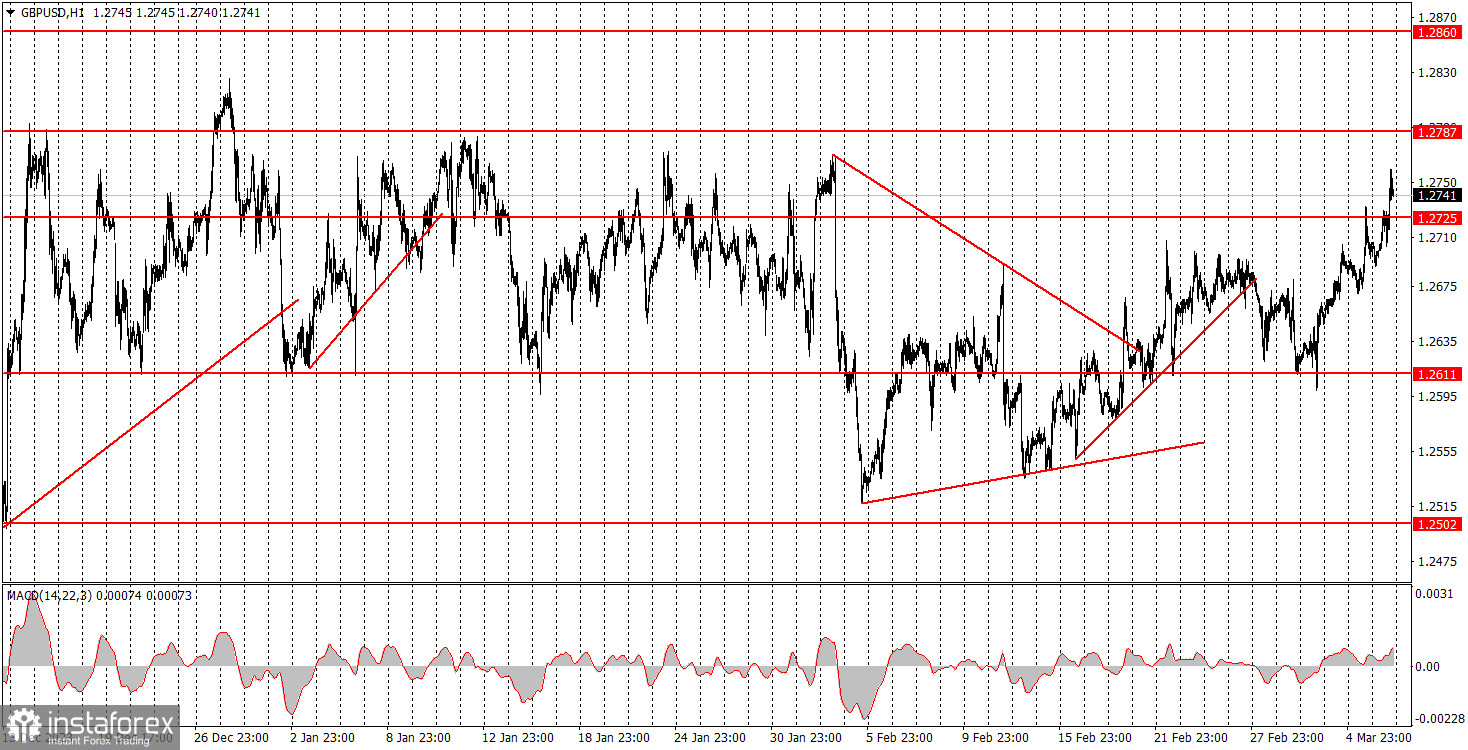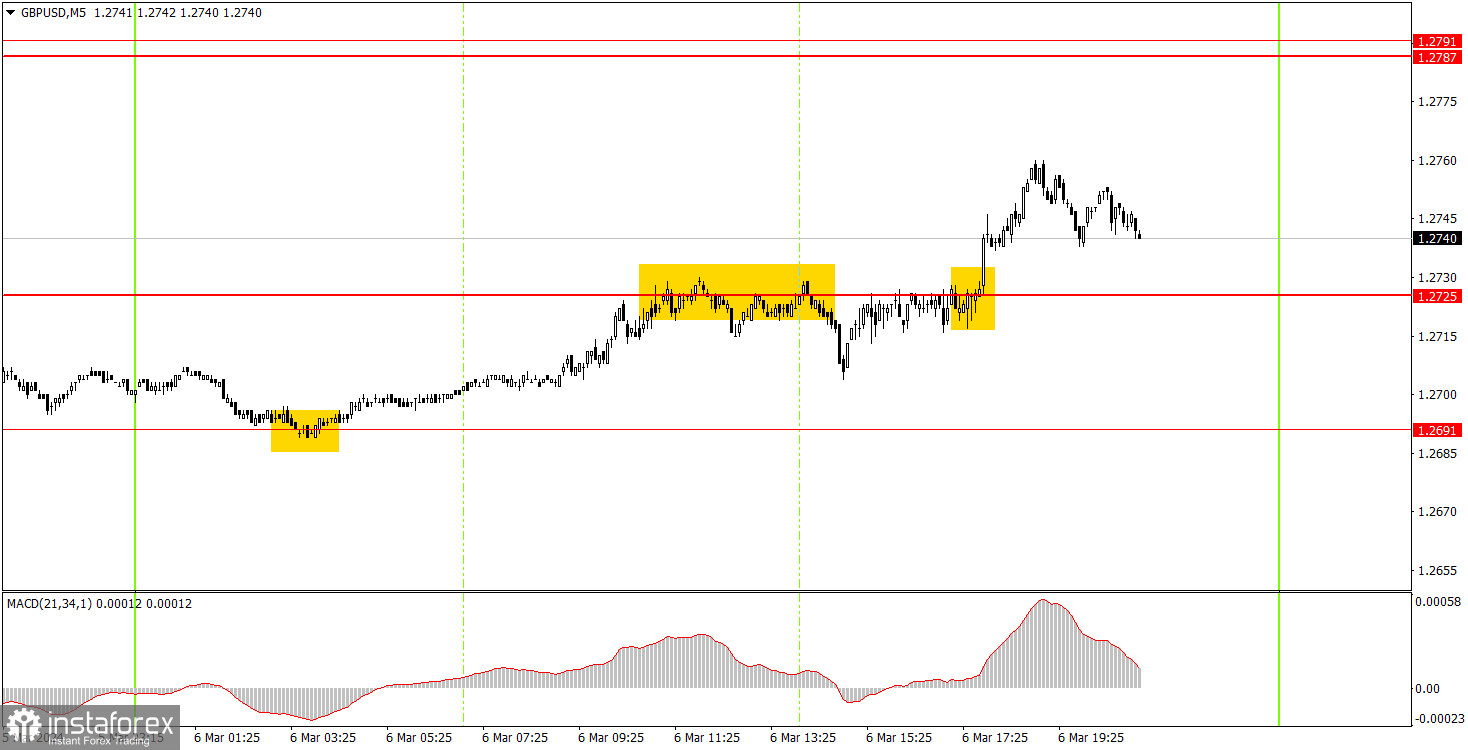Analyzing Wednesday's trades:
GBP/USD on 1H chart

GBP/USD continued to trade higher on Wednesday, extending a trend that has been persistent for two weeks. The technical picture is currently quite ambiguous. We deliberately reduced the timeframe scale to show the flat that has lasted for more than three months. A month ago, the pair broke the lower boundary of this flat (the level of 1.2611), but it seems that it was a false breakout. Now, if the pair manages to surpass the level of 1.2787, we can talk about a new phase in the global upward trend.
We have discussed the reasons why the pound has risen many times. In general, there aren't any clear reasons. The dollar still weakened on Wednesday even when Federal Reserve Chair Jerome Powell said that the Fed may keep the rate at its peak value for a longer time because inflation remains persistent. Two U.S. reports (ADP and JOLTs) were not bad enough to push the dollar to fall further. Moreover, the U.S. currency has been falling for over two weeks now.
GBP/USD on 5M chart

Several signals were formed on the 5-minute timeframe. Initially, the pair bounced off the level of 1.2691, after which it reached the nearest target - the level of 1.2725. This signal could yield around 15 pips. Next, there was a rebound from the level of 1.2725, which turned out to be a false signal, since the pair could not reach the nearest target. A small loss was incurred on this trade. Subsequently, the pair surpassed the level of 1.2725, allowing novice traders to open new long positions, resulting in minimal profit. Two out of three trades closed in profit, but it was still a small profit.
Trading tips on Thursday:
On the hourly chart, GBP/USD continues to trade flat. We expect the pound to fall, but the market is not in a rush to sell the pound. We believe that you may consider short positions on the pound if the pair consolidates below the area of 1.2605-1.2611. However, a new downturn can also start from the levels of 1.2725 and 1.2787. If the price surpasses the level of 1.2787, then there's a good chance of starting a new uptrend.
The key levels on the 5M chart are 1.2270, 1.2310, 1.2372-1.2387, 1.2457, 1.2502, 1.2544, 1.2605-1.2611, 1.2648, 1.2691, 1.2725, 1.2787-1.2791, 1.2848-1.2860, 1.2913, 1.2981-1.2993. On Thursday, there are no significant events planned in the UK, while the U.S. will only release a report on secondary jobless claims. The European Central Bank meeting may affect the pound sterling, so you can focus on this instead.
Basic trading rules:
1) Signal strength is determined by the time taken for its formation (either a bounce or level breach). A shorter formation time indicates a stronger signal.
2) If two or more trades around a certain level are initiated based on false signals, subsequent signals from that level should be disregarded.
3) In a flat market, any currency pair can produce multiple false signals or none at all. In any case, the flat trend is not the best condition for trading.
4) Trading activities are confined between the onset of the European session and mid-way through the U.S. session, after which all open trades should be manually closed.
5) On the 30-minute timeframe, trades based on MACD signals are only advisable amidst substantial volatility and an established trend, confirmed either by a trendline or trend channel.
6) If two levels lie closely together (ranging from 5 to 15 pips apart), they should be considered as a support or resistance zone.
How to read charts:
Support and Resistance price levels can serve as targets when buying or selling. You can place Take Profit levels near them.
Red lines represent channels or trend lines, depicting the current market trend and indicating the preferable trading direction.
The MACD(14,22,3) indicator, encompassing both the histogram and signal line, acts as an auxiliary tool and can also be used as a signal source.
Significant speeches and reports (always noted in the news calendar) can profoundly influence the price dynamics. Hence, trading during their release calls for heightened caution. It may be reasonable to exit the market to prevent abrupt price reversals against the prevailing trend.
Beginners should always remember that not every trade will yield profit. Establishing a clear strategy coupled with sound money management is the cornerstone of sustained trading success.





















